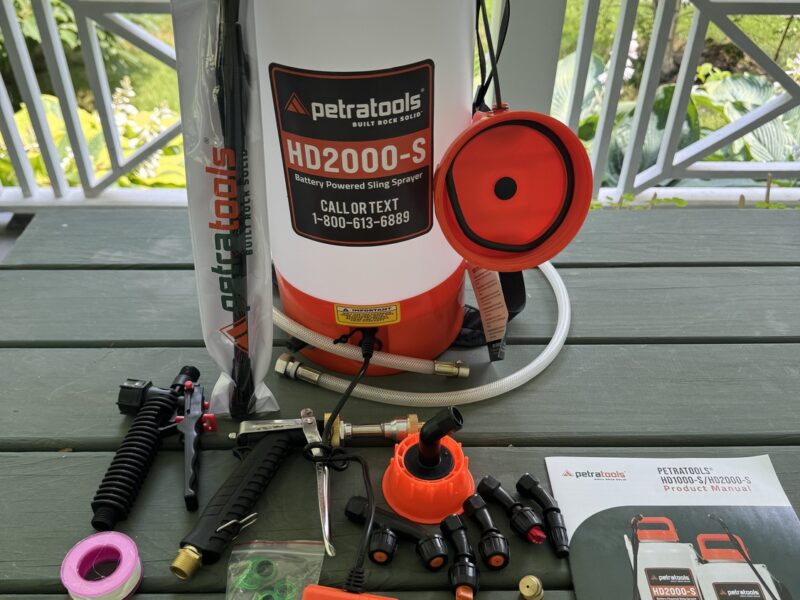

In addition to my collection of plants I also have a collection of garden tools. I refer to these as my toys. Some get used rarely, but it’s still good to have them. Others get used regularly, and like many gardeners I have my rakes, shovels, pruners and other tricks of the trade. What surprised me though was how many sprayers I have.
Having said that you might think I use a lot of insecticides, herbicides and other remedies to conquer the baddies in the gardens, trees, shrubs and lawn. I was amazed to look at the spot on the back porch where most of these sprayers call home and realize that there were nine of them. But I’ve just added a new one that will probably replace them all. Well, I may keep a 1-quart, but the rest may be off to plastic recycling if they’ll take them.
These pump-type piston sprayers range from 1-quart capacity up to 2-gallon sprayers. Some have an “I” tattooed on the plastic tanks to remind me that a particular sprayer should only be used for “I”nsecticides. Those with an “H” stenciled on them are only used for “H”erbicides. Each one is just slightly different from the others and that difference is often the “tip” at the end of the spray wand. The tip controls the way the material comes out of the sprayer. It can be a fan pattern, a stream, or a cone. But why isn’t there a sprayer that can do it all? Keep reading …
In addition to the ones on the back porch there’s a hose-end sprayer in the barn that I haven’t used in years. This is a one-sprayer-does-it-all type of sprayer, but I’ve found them to be sloppy, unreliable in their output and for the most part useless unless you need to spray your whole lawn for weeds. And even then they seem to be pretty useless since the herbicides available at local garden centers and home centers are pretty pitiful when it comes to their effectiveness.
Then there is my collection of electric (actually battery-operated) sprayers. These range from 10 to 20 gallons, and they all have longer hoses, making them more accessible in some situations. But they are a nightmare to clean, and there’s always a gallon or so of spray left over that needs a safe place to be off loaded. That’s my stone driveway. The 20-gallon unit is on its own chassis and needs to be pulled by a tractor as when it’s full it weighs more than 160 pounds. These days I use it only for getting water to remote parts of the property.
The smaller 10-gallon sprayers go into a small cart behind my small tractor or in the front bucket of my larger tractor. They’ve all been retired though (except for one that’s been sitting in its box since I bought it) as the motors (pumps) have all crapped out and I seemed to be forever tightening hose connections on and from these sprayers to fix leaks.
I also have some serious issues with the smaller sprayers that have piston or plunger hand pumps to create pressure inside the spray tank that allows you to spray several feet from where you’re standing. Maybe 20 strokes on the handle and you get a fairly good stream of spray that can go six feet high or enough pressure to spray a rose bush or other small plants.
But my biggest issue with these small compression sprayers is that they are innately dangerous. If you forget to unscrew the plunger and release the pressure from the tank when you’re done the spray can release a mist and hit you right in the face. That is not good, not good at all. Some of these sprayers actually have a tiny pressure relief valve that you can simply pull to release the pressure, and these are much, much safer.
But I’m done with them all. I hope. No more nozzle switches to get the right spray pattern or stream. No more worries about a pressure relief valve and no more double and triple rinsing to make sure there’s no residue left in the tank. And no more hose and coupling leaks.
It was actually too hot and humid from late June into the third week of July, and the only “treatments” I was able to do during those four weeks was a baking soda, Sunspray (summer oil) dip on two Phlox paniculata plants that were still in their coir shipping pots but covered with powdery mildew. These got dunked in a small bucket and not sprayed.
But with the heat and humidity slowing down my outdoor efforts I set out to see what was available in the sprayer world. I wanted to see if I could replace all or most of my sprayer collection with one sprayer. At the start I had two criteria. The sprayer had to have a 2-gallon tank and an articulated spray head so that I could put the wand under the foliage of plants and spray upward to get coverage on the undersides of the foliage. That’s one of the biggest challenges when spraying plants: good and top coverage of the foliage.
My search was quick, and I hope fruitful. I went onto the worldwide web and entered some search criteria, and the results brought me to Petratools, whose motto is “Built Rock Solid.” They are. Petra is an American company based in Pennsylvania, and after looking at their line of sprayers and many reviews I bought a Petratools HD2000-S sprayer Prokit. With discounts it cost me around $130. Now that is a lot for a 2-gallon sprayer, but it comes incredibly well equipped and is pretty amazing.
My first concern was the weight. If I lift more than a gallon of water (8 pounds) I can reasonably assume my back will hurt. But with two gallons of liquid, the tank and the motor (more in this shortly) and battery, we’re talking a lot of hurt. Ah, but you can buy an extended hose attachment, and that allows me to put the sprayer in a cart, wagon, or other wheeled device and no lifting required so long as you do your filling on the cart or wagon and don’t lift the sprayer.
Four days after ordering the sprayer, it arrived. For some reason I expected a larger box, but once opened and unpacked I was just amazed at the array of attachments the sprayer came with. There was an array of spray tips (I got the Pro model that comes with more than the standard model) to achieve just about any spray pattern you might need and a watering rose that allows you to use the sprayer like a watering can. Oh, and did I mention that the sprayer is electric? No extension cord needed.
At the bottom of the sprayer, inside the tank, is a motor that provides more than adequate pressure, allowing you to spray fruit trees to roses and smaller plants. You adjust the volume of output using the trigger grip, and there are two of these included. One is metal (well made) with an adjustable nozzle and a plastic trigger that a wand gets attached to. Then you add the tip of your choice to the end of the wand. All attachments are easy to screw on and off and the hose is not clamped to the sprayer but it has a very durable screw on device at each end — metal, not plastic. And remember, you can order one of three hose lengths when you place your order (only directly from Petra, not on Amazon.)
Back to the tank. Under the motor/pump is the battery. It’s totally sealed, and you will most likely wear out before the battery gives out. But if it does just use the wall plug charger and it will fully charge overnight. There’s a small rocker switch on the outside of the tank. Press the switch and you’ve got instant pressure as soon as you squeeze the trigger.
While I didn’t get my articulating nozzle to spray the undersides of the leaves, one of the many attachments is a dual nozzle attachment that allows you to get the wand under the foliage while the dual nozzles spray up onto foliage undersides. Wonderful!
As of this writing you can go to the Petra website and order the HD2000-S sprayer ProKit that includes the 2-gallon sprayer (yes, including the built-in battery and pump) along with at least seven nozzle attachments (including the one for watering plants) for just $130. That’s an $80 discount for the model reviewed here. You can also find extensive videos at their website with videos on each of their products.
Now, if $130 is too much for you (it’s usually $210) there is a 1-gallon model, and they also have piston pump models (manual) that only cost about $40 — and they have a pressure release valve on the tank. Good work.
One of the other notable features of the electric Petra sprayer is that there is no pressure relief valve. There’s no reason for one. Since the tank isn’t pressurized and the pressure is created by the internal pump there are no worries about opening the top of the tank and getting spray material blown into your face.
There’s a one-year warranty on this sprayer, and their customer service is exceptional. While you can use herbicides and insecticides in this sprayer I would advise against it. Yes, you need to flush the tank to clean it after every use but any residual herbicides left behind from a poor cleaning can easily damage plants the next time you spray for insects. Also make sure you have a safe place to store all the nozzles and attachments so they are available when you need them. If you are meticulously careful in your cleaning routine though you can certainly use this sprayer for both applications.
Customer service is remarkable. I called a few times and was greeted by a friendly and knowledgeable person on the other end and consumers report they always got fast and helpful responses and or replacement parts. There are also other sprayers in their line from the inexpensive manual pump sprayers and backpack sprayers to the sprayer reviewed above and others on wheeled carts that will handle many more gallons of spray on a two-wheeled or four-wheeled cart.
So, if you think I’m impressed by the sprayer and the company you’re correct. There are still a few more opportunities for me to put the sprayer through its paces, but my initial reaction is that it’s a great tool with lots of great features. You can check out the entire line here, petratools.com/collections/all-sprayers, where you’ll find a dozen sprayer options, but also check out the tab for Sprayer Parts and Accessories. Keep growing.
 More Posts from Andrew Messinger
More Posts from Andrew Messinger